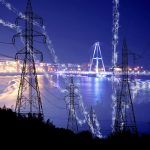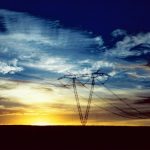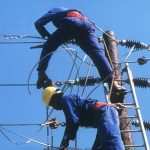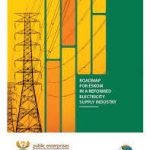Shift performance, grow sustainably
“We have delivered sound business performance indicative of the progress being made during a tough year,” Eskom’s Group Executive, Brian Dames, said, during the presentation of the annual results. “We continue to put the building blocks in place to become a sustainable company that can power the South African economy and improve the quality of life of people, now and into the future.”
Mr. Dames, who was appointed as Chief Executive of Eskom in July 2010, resigned from his position in March 2014 and was succeeded by Mr. Collin Matjilla, who served as acting Chief Executive. During Mr. Dames’ tenure, he contributed to Eskom winning awards for its environmental achievements, the quality of its financial reporting, and the title of the “Most Desired Company to Work For”, as judged by the Sunday Times.
The annual report concluded that Eskom is “in the midst of a far-reaching and complex transition” as it nears the 90-year milestone, and “when this process is completed, we will be a very different company.”
In 2013 Eskom was still Africa’s largest electricity utility – and among the top 15 in the world – and supplied about 95% of South Africa’s electricity. The number of customers exceeded, for the first time, the 5-million mark. Since the inception of the electrification programme in 1991, more than 4.3m homes were newly electrified.
Eskom’s annual report noted that the utility’s power stations are ageing and require focus to maintain and improve performance. Planned maintenance often had to be shifted or deferred to ensure that capacity is available to meet demand and keep the lights on.
It cautioned that “… the margin between supply and demand has been too narrow to take generating units off-line at the pace required for adequate scheduled maintenance.” This resulted in the declining technical performance of the power stations.
Revenue increased by 12,2%, but this was offset by escalating operating expenditures, mainly due to an increase in primary energy costs. The net profit decreased to R5.2bn, compared to R13.2bn in the previous financial year.
Lower sales were attributed to lower demand for electricity due to weaker economic conditions, demand response initiatives, industrial action in the mining sector, and major customer breakdowns.
However, surveys conducted in terms of the Eskom KeyCare measurement indicated improvements in customer satisfaction levels, and a new online vending system was introduced in July 2013.
The company highlighted the need to “re-engineer the business” to address the revenue shortfall caused by lower-than-expected tariff increases approved by Nersa. The objectives were to ensure sustained improvements in productivity and establish a long-term cost position. This would be done through disciplined execution, individual accountability, and performance management.
It installed 261MW of additional generation capacity, 787km of high-voltage transmission lines, and 3 580MVA of new transformer capacity. More than 82% of the R300bn funding required for the capacity expansion programme was secured. The intention was to spend more than R55bn over the next five years to strengthen, refurbish and expand the distribution network.
The new build projects contributed significantly to job creation and local economic development. Close 36 000 people were employed on these projects, of which almost 50% were drawn from local districts. The total local content committed by the Eskom supplier network amounted to R86bn or 63% of the total contract values awarded for the build projects.
In October 2013 Eskom signed an agreement with several key private sector partners in the Medupi construction project to extend employment opportunities beyond the completion of the project and avoid community destabilisation. The Medupi Leadership Initiative was the largest post-construction work opportunity programme yet launched in the country.
It put in place a five-year strategy for generation sustainability which includes a firm commitment not to postpone critical maintenance. This was based on an 80:10:10 principle – denoting an energy availability factor of 80%; planned maintenance of 10% and a project unplanned outage ratio of 10%,
The Grootvlei Power Station in Mpumalanga, which was mothballed two decades earlier, was recommissioned in September 2013, following a R7.2bn upgrade.
Eskom first reported that it had to use open cycle gas turbines and required consumers to reduce electricity use and switch off during peak periods to meet the energy demand. In its annual report it noted: “Eskom kept the lights on during the past winter with the help of all South Africans, hard work and disciplined delivery on goals.”
The Tutuka coal rail terminal became fully operational, but Eskom was concerned that it was purchasing more expensive coal from the short- and medium-term markets due to the poor performance of some contracted mines. The coal-supply value chain was also affected by extended strikes in the transport and mining sectors and operational challenges pertaining to the rail network.
It restated its ambition to reduce the volume of coal transported by road to power stations and initiated an investigation on how road transporters can be compensated for losses attributed to the switch from road to rail.
Eskom continued its partnerships with large industrial customers to help manage the power system during peak periods through demand response programmes. There were high concerns about rising municipal debt – especially in Gauteng – despite various interventions with municipalities. Actions to disconnect certain non-paying municipalities were averted following interventions to secure payments to settle debts.
In Soweto Eskom’s revenue management strategy included the installation of split metering and converting customers to prepaid metering.
A comprehensive initiative – “Live Lightly” – was launched in partnership with the national broadcaster to encourage South Africans to save energy by switching off lights during peak consumption periods. Both household and commercial consumers were targeted with messages on how energy can be saved in both the winter and summer months.
Energy imports from the Hydro Cahora Bassa scheme were stabilised following the repair of damaged towers caused by extensive flooding in Mozambique during the 2012/13 season.
An agreement was signed with the French development agency, AFD, to fund the development of a 100MW concentrating solar power plant near Upington in the Northern Cape. This represented Eskom’s biggest investment to date in solar power projects and contributed to the utility’s objective to reduce its carbon footprint and invest in a sustainable energy future.
It also contributed to the government’s solar water heating initiative and was closing in on its target to install some 5-mllion fluorescent bulbs in homes to further encourage a culture of saving on electricity consumption.
The Eskom Development Foundation approved funding for projects to a value of R81.6m during the financial year.
Eskom also invested R216bn into researching and testing technologies. Initiatives were launched to identify opportunities for increased efficiencies at several power stations, as well as a project to test the suitability of coal intended for the new build programmes.
It launched a research project to study the charging requirements and characteristics of electric vehicles and to determine the future impact which such vehicles will have on the national grid.
It expressed support for Government’s initiatives to facilitate the entry of independent power producers into the local electricity market, as well as the programme to bring 3 725MW generated from renewable energy onto the national grid.
Eskom recommitted itself to its safety programme which determines that no operating condition or urgency of service justifies exposing anyone to negative risks arising from its business, or causing them injury, or damaging the environment.
An accident at the Ingula power station construction site in October 2013 resulted in the tragic loss of six lives, while a further seven people sustained injuries. Work on the inclined high-pressure shaft was temporarily halted while the Department of Mineral Resources conducted an investigation.
High levels of theft of copper and pylons persisted with affected plant performance and increased costs. The Operation Khanyisa strategy and joint initiatives with the SAPS and industry bodies, however, helped to contain energy losses within acceptable parameters.
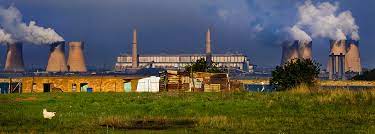
Several divisions – including Generation, construction management and the telecommunications department – received ISO 14001 certification during the year.
Eskom was the overall winner of the Nkonki Award for the best Integrated Report delivered by a state-owned company and recognised by Ernst & Young in its evaluation of such reports. It also took second place in the top brand survey conducted by the Sunday Times, for “companies who do the most to look after South Africa’s environment and natural resources”.
Far-reaching, complex transition
In 2013 Eskom was Africa’s largest electricity utility, among the top 15 in the world and supplied 95% of South Africa’s electricity; reaching 5 million customers for the first time while more than 4.3m homes were newly electrified since 1991.
The annual report noted that Eskom is “in the midst of a far-reaching and complex transition” which will make it a “a very different company”. Group Chief Executive Brian Dames pointed to a “sound business performance indicative of the progress being made during a tough year” and stressed: “We continue to put the building blocks in place to become a sustainable company.”
The report also noted that power stations are ageing and require ‘focus’ to maintain and improve performance. Planned maintenance often had to be shifted or deferred to ensure that capacity to meet demand is available.
Revenue increased by +/- 12%. This was offset by escalating operating costs. Eskom intended spending more than R550bn over the next five years to strengthen, refurbish and expand the distribution network.
New build projects contributed significantly to job creation and local economic development. Close to 36 000 people were employed on these projects, some 50% from local districts. Local content from the supplier network amounted to R86bn – 63% of the total contract value.
Key private sector partners signed an agreement with Eskom to extend employment opportunities beyond the completion of the Medupi construction to avoid community destabilisation – the largest post-construction work opportunity programme in the country.
The Grootvlei power station in Mpumalanga was recommissioned, following a R7.2bn upgrade and the Tutuka rail terminal became fully operational. Of concern was the procurement of more expensive coal due to poor performance by some contracted mines, the effect of extended strikes in the transport and mining sectors plus operational challenges in the rail network.
Eskom restated its intention to reduce the coal volume transported by road to power stations and switching from road to rail.
Energy imports from Cahora Bassa were stabilised following damage repairs caused by extensive flooding in Mozambique while an agreement was signed with the French development agency, AFD, to fund the development of a 100MW solar power plant near Upington – Eskom’s biggest investment in solar power, contributing to the objective of reducing its carbon footprint.
It [L1] also contributed to the government’s solar water heating initiative and came close to installing some five million fluorescent bulbs in homes to further encourage a culture of saving on electricity consumption. And supported the government’s initiative to facilitate the entry of independent power producers into the local electricity market and to bring 3 725MW generated from renewable energy onto the national grid.
R216bn went to research and testing technologies, increased efficiencies at power stations were identified and the suitability of coal for new build programmes tested. Eskom continued its partnerships with large industrial customers to help manage the power system during peak demand periods and households as well as commercial consumers were encouraged through a comprehensive communication [L2] initiative to save energy by switching off lights during peak consumption periods.
It also looked into the charging requirements of electric vehicles.
Its integrated report was rated the best by a state-owned company and it came second in a top brand survey of companies which look after the environment and natural resources.
The Eskom Development Foundation approved R81.6m in funding for projects.

